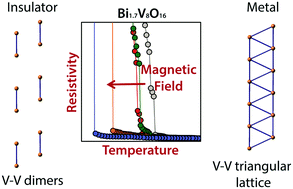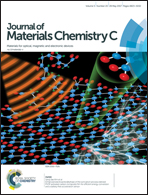Metal–insulator transition tuned by magnetic field in Bi1.7V8O16 hollandite†
Abstract
A metal–insulator transition tuned by application of an external magnetic field occurs in the quasi-one dimensional system Bi1.7V8O16, which contains a mix of S = 1 and S = 1/2 vanadium cations. Unlike all other known vanadates, the magnetic susceptibility of Bi1.7V8O16 diverges in its insulating state, although no long-range magnetic ordering is observed from neutron diffraction measurements, possibly due to the frustrated geometry of the triangular ladders. Magnetotransport measurements reveal that the transition temperature is suppressed upon application of an external magnetic field, from 62.5 K at zero field to 40 K at 8 T. This behavior is both hysteretic and anisotropic, suggesting t2g orbital ordering of the V3+ and V4+ cations drives a first-order structural transition. Single crystal X-ray diffraction reveals a charge density wave of Bi3+ cations with a propagation vector of 0.846c*, which runs parallel to the triangular chain direction. Neutron powder diffraction measurements show a first-order structural transition, characterized by the coexistence of two tetragonal phases near the metal–insulator transition. Finally, we discuss the likelihood that ferromagnetic V–V dimers coexist with a majority spin-singlet state below the transition in Bi1.7V8O16.



 Please wait while we load your content...
Please wait while we load your content...